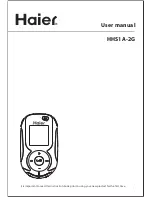
Installation
Vidikron VDP-80-720 Owner’s Operating Manual
15
PRE
L
IMINAR
Y
3.3
Installation Considerations
Proper installation of your VDP-80-720 will ensure the highest possible picture quality.
Whether you are installing the VDP-80-720 temporarily or permanently, you should take the
following into account to ensure that it performs optimally.
•
Keep the cooling vents clear of obstructions to provide for convection cooling.
•
Keep the ambient temperature constant and below 35°C (95°F). Keep the VDP-80-720
away from heating and/or air conditioning vents. Changes in temperature may cause
drifts in the display circuitry, which may affect performance.
•
Keep the VDP-80-720 away from devices that radiate electromagnetic energy such as
motors and transformers. Common sources of these include slide projectors, speakers,
power amplifiers and elevators.
•
Set the unit away from heat, excessive dust, and direct sunlight.
•
Protect the inside of the unit from liquids and small metal objects. In case of accident,
unplug the power cord and have it serviced by an authorized Service Center.
•
For correct installation and mounting Vidikron strongly recommends using a trained,
authorized dealer.
•
Proper calibration is as important for attaining the best picture as are deinterlacing and
scaling. If you don’t have one, purchase a DVD setup disc, such as AVIA, or Digital Video
Essentials and watch the training lessons provided. Then, follow the calibration
instructions on the disc and in this manual.
•
Using high-quality cables is a very important part of video quality.
•
Use a power conditioner for the video source, video processor and the display. Power line
noise is at least as important an issue for video as it is for audio.
•
Use the DVI-D output if supported by the display.
•
For display of PC generated data, such as spreadsheets, the PC resolution should be set to
match the native resolution of the display.
•
Avoid running video signals through the video switch inside receivers, as these tend to
degrade video quality. The rule of thumb for a video switch is to have 10 times the
bandwidth of the video being switched. This equates to about 50 MHz for SDTV switching,
and 300 MHz for HDTV switching.
•
A system’s “ground loop noise” can cause visible horizontal banding. This shows as a
screen-width horizontal band of intensity variation. Since the VDP-80-720 case “floats”
with reference to ground, it may need to be grounded to the video source or display using
an 18-gauge or heavier wire.
•
Component DVD sources provide the best standard-definition picture quality. S-Video
sources are often a bigger challenge and therefore can show more improvement using
the VDP-80-720. Since for many satellite receivers, and other video sources, SVideo is the
best output, improved SVideo performance is important for many installations.
•
For standard definition programming using cable/satellite set top boxes, it is best to have
the set top output standard definition, interlaced video (480i or 576i). If this is not
supported, use 480p output for standard definition programming. This allows the
VDP-80-720 to deinterlace and scale the video rather than the set top box.
Summary of Contents for VDP-720
Page 2: ......
Page 10: ...List of Figures x Vidikron VDP 80 720 Owner s Operating Manual P R E L I M I N A R Y ...
Page 48: ...Operation 38 Vidikron VDP 80 720 Owner s Operating Manual P R E L I M I N A R Y Notes ...
Page 54: ...Specifications 44 Vidikron VDP 80 720 Owner s Operating Manual P R E L I M I N A R Y Notes ...
Page 55: ......
















































